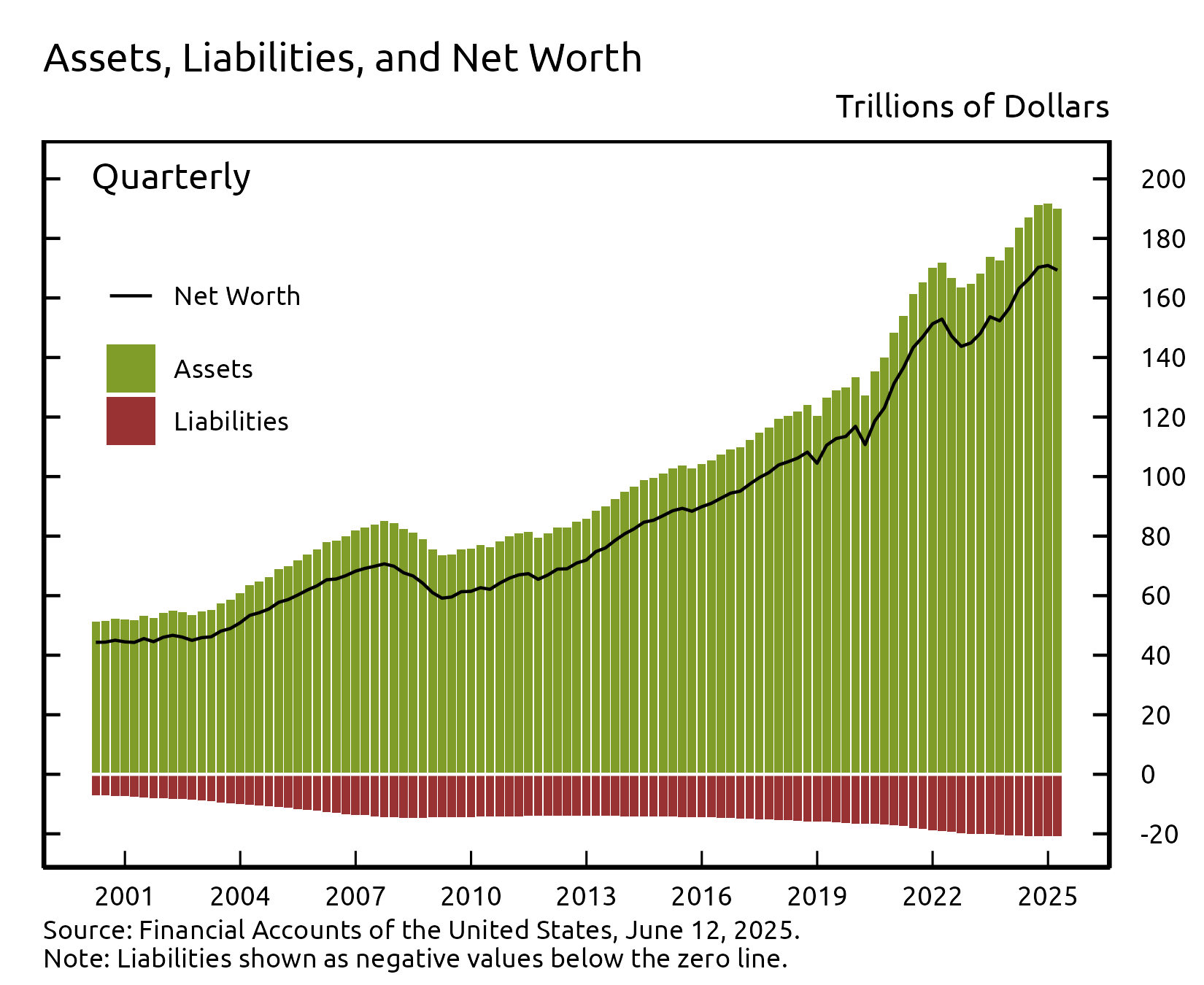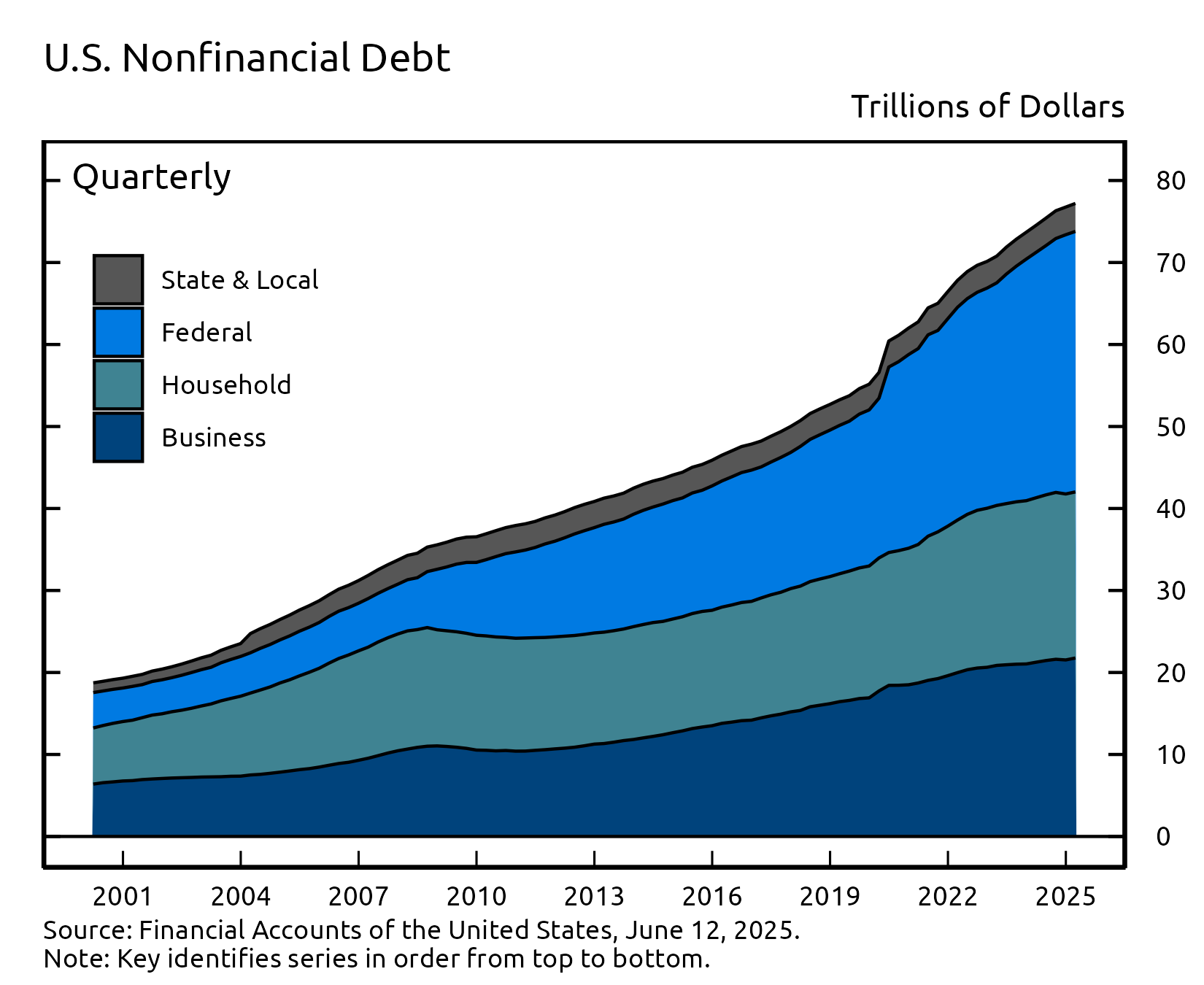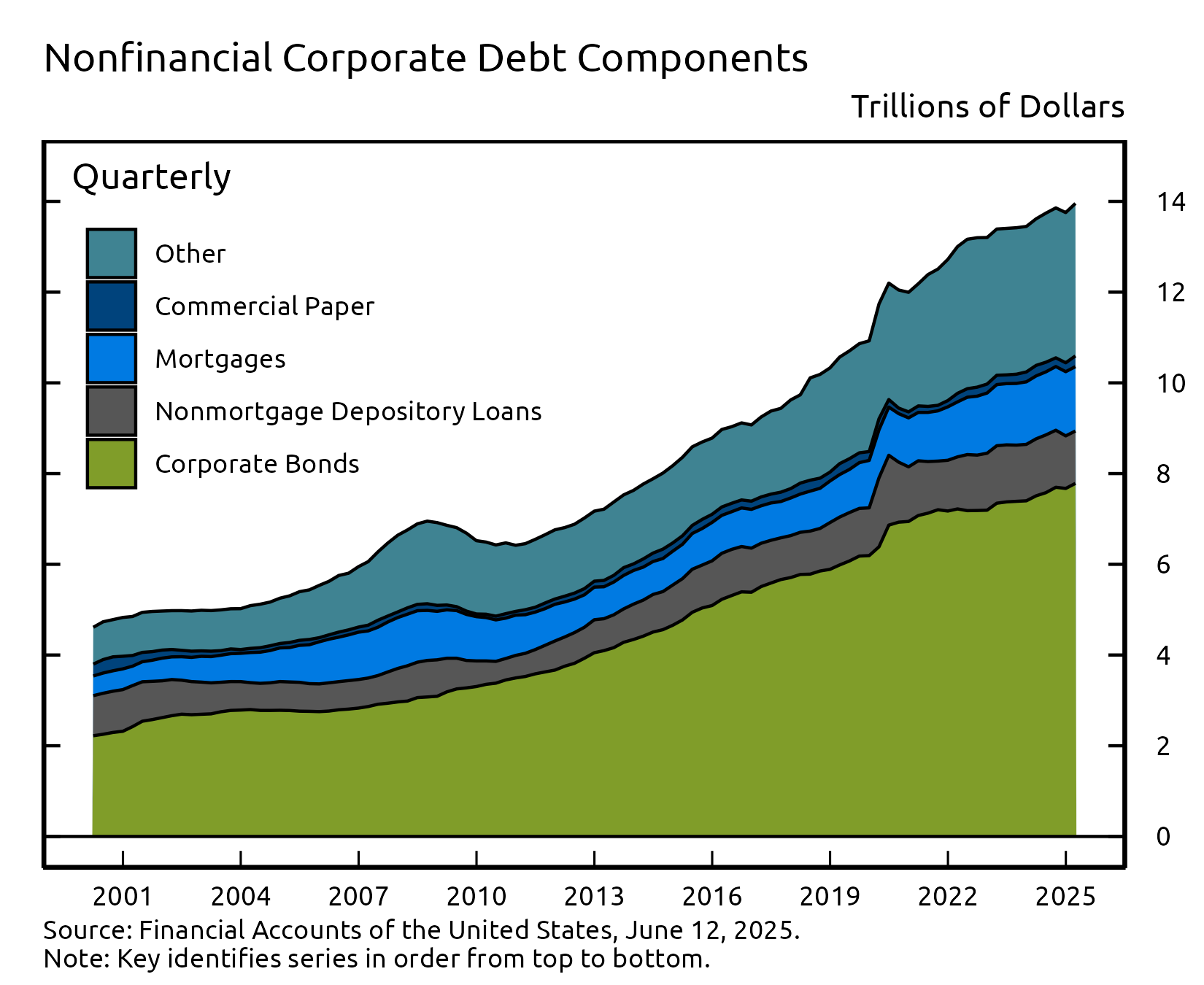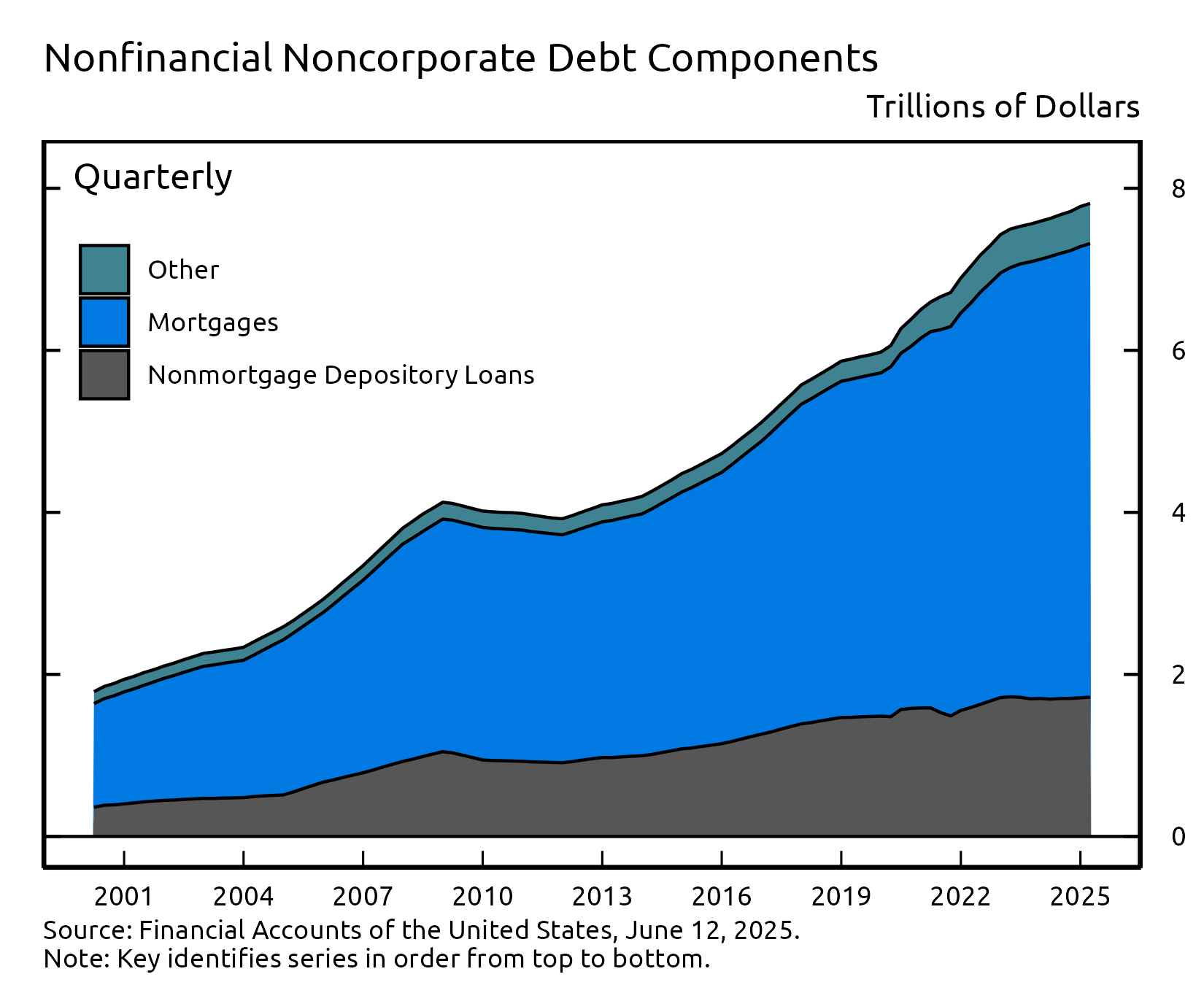Financial Accounts of the United States - Z.1
Recent Developments RSS Data Download
The recent developments discussed below refer to data through March 31, 2025.
- Household net worth decreased by $1.6 trillion in the first quarter of 2025, primarily reflecting losses on corporate equity assets.
- Household debt increased at a seasonally adjusted annual rate of 1.9% in the first quarter, reflecting modest growth of mortgage debt and slower growth of nonmortgage consumer credit.
- Nonfinancial business debt expanded 4.8% at a seasonally adjusted annual rate in the first quarter, driven by robust issuance of debt securities and continued growth in loans.
Household Net Worth
The net worth of households and nonprofit organizations decreased by $1.6 trillion to $169.3 trillion in the first quarter. The value of directly and indirectly held equity on the household balance sheet decreased by $2.3 trillion in the first quarter, while the value of directly and indirectly held debt securities rose by $0.2 trillion. The value of owner-occupied real estate decreased by $0.2 trillion, as house prices continued to decline for the third consecutive quarter.

View interactive | Accessible version | CSV | Data Dictionary | Chart Note (1) |
Directly and indirectly held corporate equities ($55.6 trillion) and household real estate ($47.9 trillion) remain the largest components of household net worth.

View interactive | Accessible version | CSV | Data Dictionary |
Household Balance Sheet Summary
| Description | 2023 | 2024 | 2024:Q2 | 2024:Q3 | 2024:Q4 | 2025:Q1 |
|---|---|---|---|---|---|---|
| Net Worth | 156.60 | 170.90 | 166.29 | 170.26 | 170.90 | 169.31 |
| Change in Net Worth | 11.70 | 14.30 | 3.11 | 3.97 | 0.64 | -1.59 |
| Equities | 48.66 | 57.91 | 54.05 | 57.32 | 57.91 | 55.58 |
| Change in Equities | 7.85 | 9.24 | 1.11 | 3.27 | 0.59 | -2.33 |
| Real Estate | 44.91 | 48.14 | 48.77 | 48.55 | 48.14 | 47.93 |
| Change in Real Estate | 2.31 | 3.23 | 1.80 | -0.22 | -0.41 | -0.20 |
For more data on household net worth, see table B.101
Nonfinancial debt
Total domestic nonfinancial debt grew at an annual rate of 2.8% in the first quarter, down from the 4.7% pace recorded last year (this and subsequent rates of growth are reported at a seasonally adjusted annual rate). The first-quarter slowdown was primarily driven by a decrease in federal government borrowing. Private nonfinancial debt growth picked up, boosted by a significant increase in business borrowing amid slower growth in household debt.
Household debt growth slowed to a 1.9% pace in the first quarter of 2025, the lowest rate seen since the second quarter of 2020. Home mortgage debt expanded by 2.3% and nonmortgage consumer credit grew by 1.3%.
Nonfinancial business debt expanded at a 4.8% pace in the first quarter, a noticeable step up in growth relative to the previous two quarters. This acceleration was mainly driven by robust net issuance of debt securities, including corporate bonds and commercial paper, by nonfinancial corporations. The debt growth of nonfinancial noncorporate businesses slowed slightly in the first quarter.
Federal government debt increased at a 2.0% pace in the first quarter, a notable deceleration as the U.S. Department of the Treasury drew down cash balances and used extraordinary measures to remain below the statutory debt limit. State and local government debt expanded at an annual rate of 4.3% after contracting at a 1.3% pace in the previous quarter.
Total domestic nonfinancial debt outstanding (seasonally adjusted) was $77.2 trillion in the first quarter, of which household debt was $20.3 trillion, nonfinancial business debt was $21.8 trillion, and total government debt was $35.2 trillion. The ratio of nonfinancial debt outstanding to GDP in the first quarter was 258%, about the same as in recent quarters. For more data on nonfinancial debt, see table D.1 (rates of debt growth), table D.2 (borrowing), and table D.3 (debt outstanding).
Debt Growth by Sector
| Description | 2023 | 2024 | 2024:Q2 | 2024:Q3 | 2024:Q4 | 2025:Q1 |
|---|---|---|---|---|---|---|
| Total Nonfinancial | 5.09 | 4.70 | 4.68 | 4.78 | 4.46 | 2.82 |
| Households and Nonprofits | 2.67 | 3.08 | 2.91 | 2.91 | 3.34 | 1.85 |
| Nonfinancial Business | 1.99 | 2.90 | 3.87 | 2.86 | 0.77 | 4.75 |
| Federal Government | 9.76 | 7.28 | 6.31 | 7.44 | 8.41 | 1.95 |
| State and Local Governments | 0.72 | 3.01 | 6.04 | 4.13 | -1.31 | 4.35 |
Debt Outstanding by Sector
| Description | 2023 | 2024 | 2024:Q2 | 2024:Q3 | 2024:Q4 | 2025:Q1 |
|---|---|---|---|---|---|---|
| Total Nonfinancial | 73.70 | 76.76 | 75.41 | 76.31 | 76.76 | 77.20 |
| Households and Nonprofits | 19.91 | 20.24 | 20.20 | 20.35 | 20.24 | 20.26 |
| Nonfinancial Business | 21.04 | 21.53 | 21.46 | 21.61 | 21.53 | 21.76 |
| Federal Government | 29.47 | 31.62 | 30.40 | 30.97 | 31.62 | 31.77 |
| State and Local Governments | 3.28 | 3.37 | 3.35 | 3.39 | 3.37 | 3.41 |

Accessible version | CSV | Data Dictionary |

Accessible version | CSV | Data Dictionary |
Looking at the components of nonfinancial business debt, corporate bonds increased by about $111 billion in the first quarter while mortgage loans increased by $33 billion. Commercial paper outstanding rose by about $40 billion while nonmortgage loans at depository institutions increased by about $24 billion. Other nonbank nonmortgage loans rose by $45 billion in the first quarter.
Outstanding nonfinancial corporate debt was $14.0 trillion. Corporate bonds, at roughly $7.8 trillion, accounted for 56% of the total debt. Mortgage loans were about $1.4 trillion, while nonmortgage depository loans were approximately $1.2 trillion. Other types of debt include loans from nonbank financial institutions, loans from the federal government, industrial revenue bonds, and commercial paper.
The nonfinancial noncorporate business sector consists mostly of smaller businesses, which are typically not incorporated. Nonfinancial noncorporate business debt was $7.8 trillion in the first quarter. Mortgage loans, at roughly $5.6 trillion, accounted for about 72% of the total, while nonmortgage depository loans ($1.7 trillion) accounted for most of the remainder.

Accessible version | CSV | Data Dictionary |

Accessible version | CSV | Data Dictionary |
For more data on nonfinancial business balance sheets, including debt, see tables B.103 and B.104.
Coming soon
- Enhanced
Financial Accounts Projects will be updated on Friday,
June 20, 2025, including the Distributional Financial
Accounts, which provide a quarterly estimate of the
distribution of U.S. household wealth.
- Financial Accounts data for the second quarter of 2025 will be published on Thursday, September 11, 2025, at 12:00 noon.
Chart Notes
- Changes in net worth consist of transactions, revaluations, and other volume changes. Corporate equity and debt securities include directly and indirectly held securities. Real estate is the value of owner-occupied real estate. Other includes equity in noncorporate businesses, consumer durable goods, fixed assets of nonprofit organizations, and all other financial assets apart from corporate equities and debt securities, net of liabilities, as shown on table B.101 Balance Sheet of Households and Nonprofit Organizations.